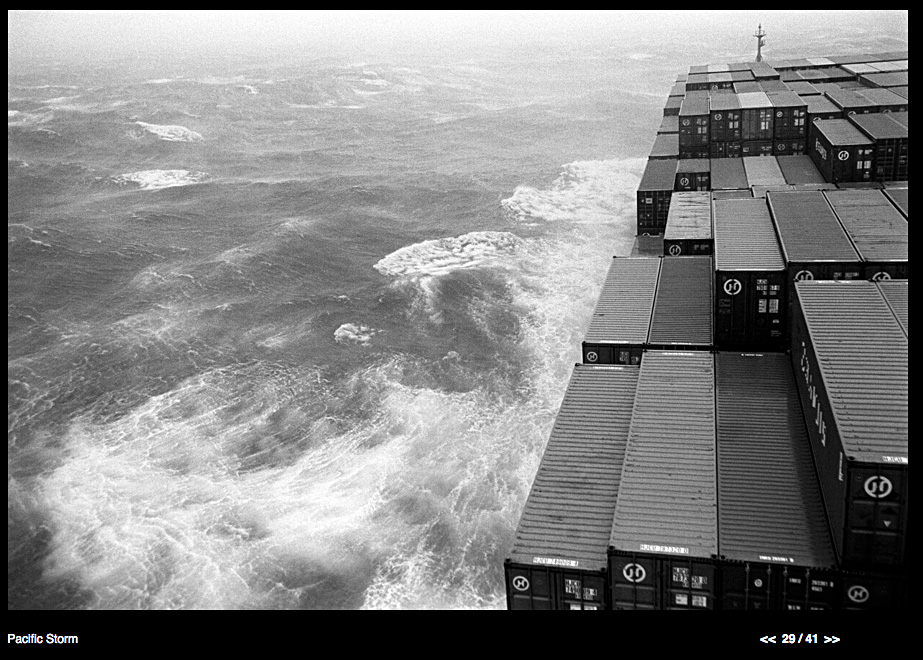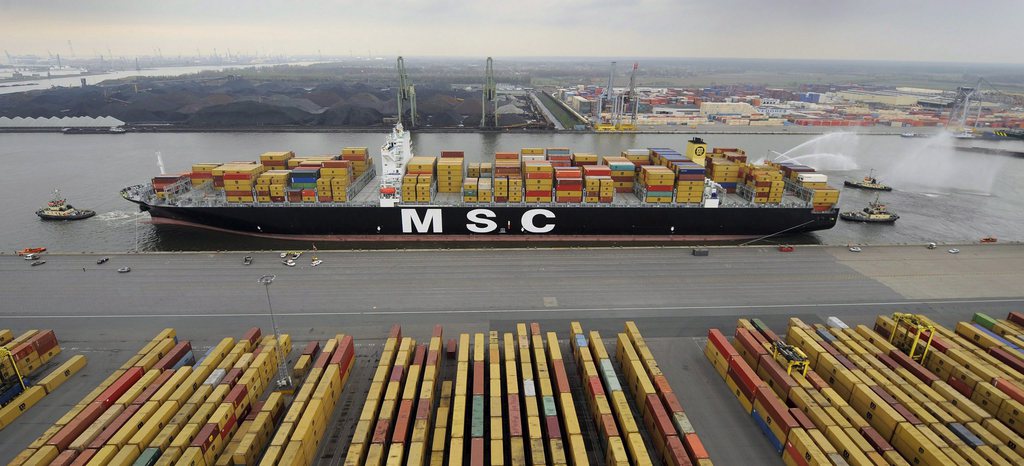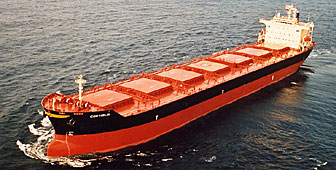Flying the Swiss flag on the high seas

It might seem strange for a landlocked country to have a merchant navy, but the 41 commercial ships sailing under the Swiss flag represent a vital plank in Switzerland’s defence planning in the case of global crises.
The Swiss merchant fleet, whose home port is Basel but whose ships never sail within sight of Swiss soil, was founded in 1941 when, as the war escalated, finding new avenues to bring essential economic supplies into Switzerland was paramount.
Today the fleet, which contributes just a fraction to Switzerland’s gross domestic product compared with the large, foreign-owned shipping companies operating out of Geneva, is maintained to serve the same goal.
Six privately owned companies own and operate a range of commercial ships, from container ships to tankers, under the Swiss flag. They do so on the condition that they may be asked to change cargo and course at the behest of the government.
“We have a very varied fleet and the policy is that the fleet should guarantee the supplies of certain goods which become scarce in a crisis, and in that case the government can ask the shipowners to transport certain goods for the sake of Switzerland,” Reto Dürler, head of the Swiss Maritime Navigation Office, told swissinfo.ch.
“They are run under commercial aspects and the government has no say in their itineraries.”
In return for their flexibility, the Swiss government, while not subsidising the fleet as such, provides loan guarantees – to the tune of SFr1.1 billion ($1.12 billion) – to help shipowners finance the purchase of new ships.
“It’s compensation for the small risk the shipowners run that maybe one day they’ll have to put their ships at the disposal of the Swiss government,” Dürler said, adding that Switzerland now has one of the most modern merchant fleets in the world.
And the Swiss fleet is growing: from 32 ships in June 2008 to the current 41, with two more on order and due to be delivered by the end of the year.
Not unique
Far from being unique, several landlocked countries including Mongolia, Slovakia, Kazakhstan and Bolivia also operate merchant fleets.
Of the 156 countries which have merchant fleets, Switzerland ranked 76 in terms of size in 2010, according to the CIA World Factbook.
What is perhaps more interesting about the Swiss fleet than its size is the fact that it is growing at a time when global shipping is contracting.
Ian Lewis, a journalist with shipping industry news publication TradeWinds has been covering the sector for some 20 years. He said that following the economic crisis in 2008, the industry was left with an oversupply of ships of all kinds. Bulkers earning their owners $200,000 (SFr196,400) a day before the crisis have seen profits lacerated to about $5,000 a day.
“At this point I think it’s unnecessary,” Lewis said, when asked about the expansion of the Swiss fleet. “There are too many ships and building more is not going to help.”
But being modern could give Swiss-flagged ships an advantage in other respects. Lewis said big transport charter companies were increasingly reluctant to hire older ships. He pointed to the MSC Napoli, which was 16 years old and under charter to the Italian Mediterranean Shipping Company (MSC), based in Geneva, when she ran aground in the English Channel in 2007.
“The biggest worry for [ship] owners now is the age of ships and the condition they are kept in, because the last thing you want is for a ship to sink like the MSC Napoli … you’ve got a huge problem on your hands,” Lewis said.
“So what people look at is the age of the ships. Anything over about 15 years old is considered a bit questionable.”
Foreign crews
As is the case with ships sailing under the flags of most Western countries, crews on Swiss ships largely comprise Asian or Eastern European sailors.
Dürler said that as international travel had become easier and cheaper, the lure of life as a sailor had faded. Whereas in the 1960s or 1970s several hundred Swiss worked as sailors, now they account for less than one per cent of the crew on Swiss ships.
Hans-Peter Schwab, a retired seaman who begans his career on Swiss-flagged ships, told swissinfo.ch that when he began sailing in 1965, few other opportunities existed if one wanted to see the world.
“I started on Swiss-flagged ships, but in 1972 left my last Swiss ship for free-flag – some people also call it a flag of convenience. For me it was convenient as I could earn almost double the salary at the time,” he said.
“This of course depended on the company. I sailed on American and Greek-owned ships.”
Schwab said that while he was unsure of salary rates today, “for all the Eastern Europeans or Asians who make up most crews nowdays, wages are certainly higher than comparable salaries in their own countries”.
Lewis said one of the major challenges for shipowners was the lack of trained, skilled officers.
Pirate threat
Another challenge for Swiss-flagged vessels, which travel on average once a month through the Gulf of Aden and adjacent African coast, is the growing pirate threat.
Despite Switzerland’s neutral status, there have been several thwarted attempts to high-jack Swiss-flagged vessels, according to Dürler.
Vessels of other countries can look to their national navy for protection, but in the absence of Swiss military protection on the high seas, what can the captains of Swiss-flagged ships do to protect themselves?
Lewis said that ship captains of all colours had been asking to be permitted to have armed guards on board to deter pirates in light of a perceived lack of protection from their associated military navies.
Declining to detail Swiss protection measures, Dürler said Swiss shipowners are required to “strictly adhere” to best practice standards to deter piracy off the coast of Somalia and in the Arabian Sea set out by international shipping association Bimco.
“Each shipowner has his special ways of enforcing the means to deter pirate attacks,” Dürler said.
With the delivery of cargo by the Rhine blocked by the Germans and the British embargo on Greek-flagged ships chartered by Switzerland in 1941, the Swiss government enacted the Federal Maritime Act to allow vessels to be registered under the Swiss flag and ensure the supply of essential goods to the country during the war.
Basel was designated as the port of registration and became home to the Swiss Maritime Navigation Office and the Maritime Ships register.
The first ships to sail under the Swiss flag were used to transport aid and help parcels from the British and American Red Cross, as well as letters and parcels for POWs.
With sea blockades imposed by all sides during the war, Swiss ships were required to submit detailed voyage information to both Allied and German officials. Checkpoints were installed and ships stopped and searched. Notebooks, diaries, sketches and other personal items were not allowed and were confiscated if found during a search.
Ships carried the word SWITZERLAND in large white letters on both sides of the hull, they were brightly illuminated at night and the Swiss flag was painted on to the superstructure wherever possible.
(Source: swiss-ships.ch)
In 2008, parliament approved the extension by SFr500 million to SFr1.1billion of loan guarantees through to 2017 to ensure the renewal and enlargement of the Swiss merchant fleet.
Ships must meet certain criteria to be eligible for assistance under the guarantee loan scheme. The composition of the fleet aims to be modern, diverse and able to carry a range of goods.
Loan guarantees will not be given to ships which have a width larger than 32.30 metres, ensuring they are able to traverse the Panama Strait. Capacity must be more than 10,000 deadweight tonnes (dwt) and less than 80,000 dwt. Tankers are limited to capacity of 40,000 dwt and must have a double hull. Ships must be technologically modern: loan guarantees will not be given to ships older than eight years.
Under the system, loan guarantees can cover up to 85% of the purchase price over a period of 15 years for new-builds. Shipowners must assume 50% of the loan within the first half of the loan period. Under the scheme they also benefit from reduced interest rates.
(Source: Federal Office for National Economic Supply )

In compliance with the JTI standards
More: SWI swissinfo.ch certified by the Journalism Trust Initiative











You can find an overview of ongoing debates with our journalists here . Please join us!
If you want to start a conversation about a topic raised in this article or want to report factual errors, email us at english@swissinfo.ch.